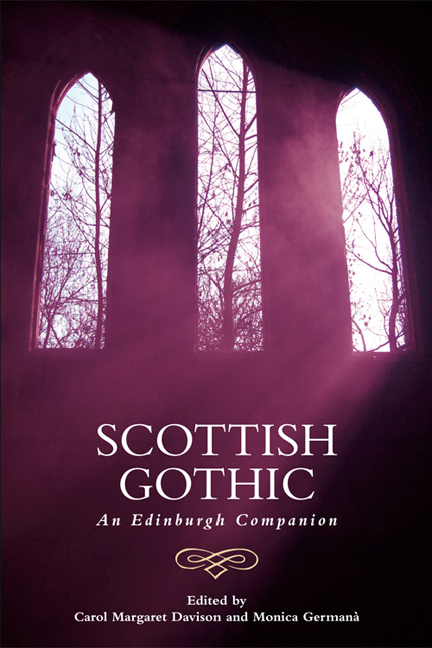Book contents
- Frontmatter
- Contents
- Acknowledgements
- 1 Borderlands of Identity and the Aesthetics of Disjuncture: An Introduction to Scottish Gothic
- 2 ‘The Celtic Century’ and the Genesis of Scottish Gothic
- 3 The Politics and Poetics of the ‘Scottish Gothic’ from Ossian to Otranto and Beyond
- 4 Robert Burns and the Scottish Bawdy Politic
- 5 Scottish Gothic Drama
- 6 Scottish Gothic Poetry
- 7 Calvinist and Covenanter Gothic
- 8 Gothic Scott
- 9 Gothic Hogg
- 10 ‘The Singular Wrought Out into the Strange and Mystical’: Blackwood's Edinburgh Magazine and the Transformation of Terror
- 11 Gothic Stevenson
- 12 J. M. Barrie's Gothic: Ghosts, Fairy Tales and Lost Children
- 13 The ‘nouveau frisson’: Muriel Spark's Gothic Fiction
- 14 Scottish Gothic and the Moving Image: A Tale of Two Traditions
- 15 New Frankensteins; or, the Body Politic
- 16 Queer Scottish Gothic
- 17 Authorship, ‘Ghost-filled’ Islands and the Haunting Feminine: Contemporary Scottish Female Gothic
- Notes on Contributors
- Index
11 - Gothic Stevenson
Published online by Cambridge University Press: 20 December 2017
- Frontmatter
- Contents
- Acknowledgements
- 1 Borderlands of Identity and the Aesthetics of Disjuncture: An Introduction to Scottish Gothic
- 2 ‘The Celtic Century’ and the Genesis of Scottish Gothic
- 3 The Politics and Poetics of the ‘Scottish Gothic’ from Ossian to Otranto and Beyond
- 4 Robert Burns and the Scottish Bawdy Politic
- 5 Scottish Gothic Drama
- 6 Scottish Gothic Poetry
- 7 Calvinist and Covenanter Gothic
- 8 Gothic Scott
- 9 Gothic Hogg
- 10 ‘The Singular Wrought Out into the Strange and Mystical’: Blackwood's Edinburgh Magazine and the Transformation of Terror
- 11 Gothic Stevenson
- 12 J. M. Barrie's Gothic: Ghosts, Fairy Tales and Lost Children
- 13 The ‘nouveau frisson’: Muriel Spark's Gothic Fiction
- 14 Scottish Gothic and the Moving Image: A Tale of Two Traditions
- 15 New Frankensteins; or, the Body Politic
- 16 Queer Scottish Gothic
- 17 Authorship, ‘Ghost-filled’ Islands and the Haunting Feminine: Contemporary Scottish Female Gothic
- Notes on Contributors
- Index
Summary
When Stevenson tackled Scottish subjects for the first time in his fiction it was, as Stephen Arata has observed, ‘by way of the Gothic’ (2010: 59). ‘Thrawn Janet’, ‘The Body Snatcher’ and ‘The Merry Men’ were all written on the author's return to Scotland from North America, during a sojourn in Pitlochry and Braemar in the wet summer of 1881. This chapter will propose that from these Scottish roots Stevenson went on to develop the Gothic genre to explore his sense of the nature of human identity and, beyond that, the conditions of material existence itself. It will trace such mutations at work in three specifically ‘Gothic’ texts, ‘Thrawn Janet’ (1881), Strange Case of Dr Jekyll and Mr Hyde (1886) and ‘Olalla’ (1885), in order to demonstrate Stevenson's evolving engagement with the genre, and its importance to any critical understanding of his work.
A ‘Gothic’ approach to identity and being was not unique to Stevenson for literary critics have noted how Scottish culture in general in the late eighteenth and nineteenth centuries tended to play the more ‘rational’ claims of modernity and the Enlightenment against older discourses from traditional culture, oral lore and superstition. Ian Duncan has argued that ‘the thematic core’ of Scottish Gothic grows from the disjunctions created when an increasingly modern and urban population seeks its national identity by turning to a ‘cultural otherness designated as pre-modern’ (2012: 123). Arata agrees that this disjunction produced ‘an intimate estrangement’ in the relationship between Scottish writers and the icons of national culture in the nineteenth century, and argues that Stevenson, growing up in a respectable family of civil engineers, haunted by his nurse's tales of Covenanting martyrs and eerie folklore, was especially subject to ‘psychic splittings and fragmentations’ (2010: 60).
Gothic writing is characterised by its engagement with what has been or should be repressed, and the suspicion that dreams and fancies, or the cellar and the dusty attic (metaphors for the unconscious) may contain more than we suspect, working in unforeseen ways. Prompted by the many readers who asked about the genesis of Strange Case of Dr Jekyll and Mr Hyde, Stevenson produced ‘A Chapter on Dreams’ for Scribner's Magazine in 1887, to recount the dream that generated his tale, and to reflect on the workings of his own unconscious.
- Type
- Chapter
- Information
- Scottish GothicAn Edinburgh Companion, pp. 142 - 154Publisher: Edinburgh University PressPrint publication year: 2017



